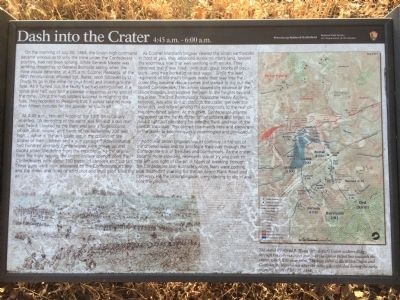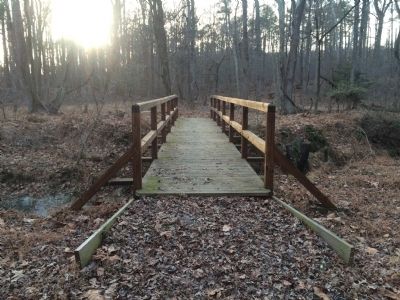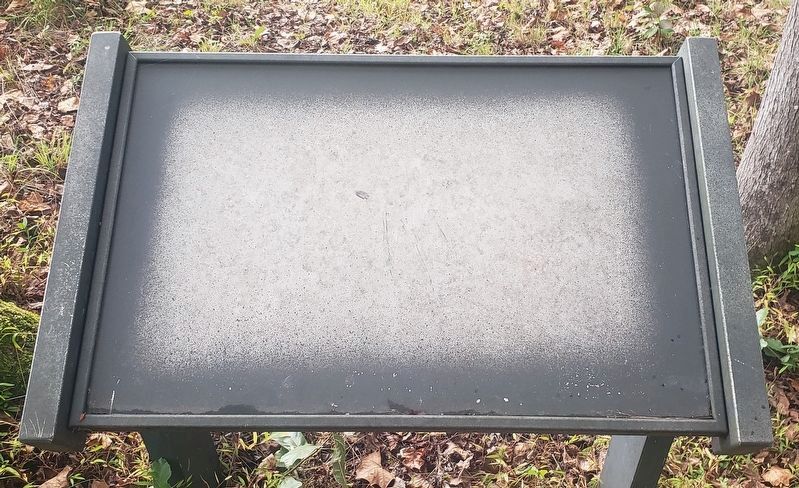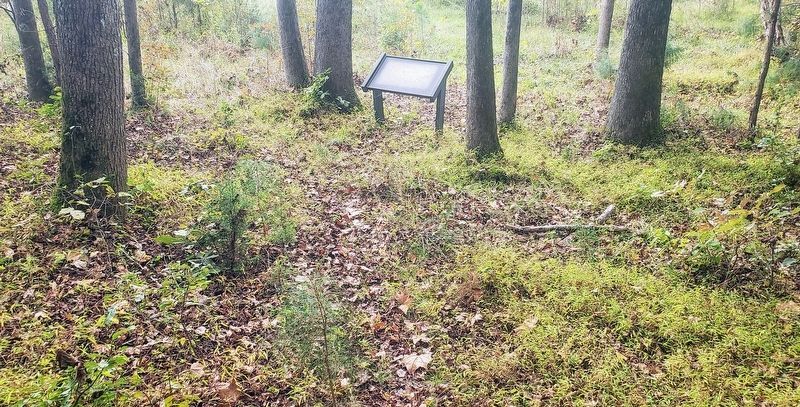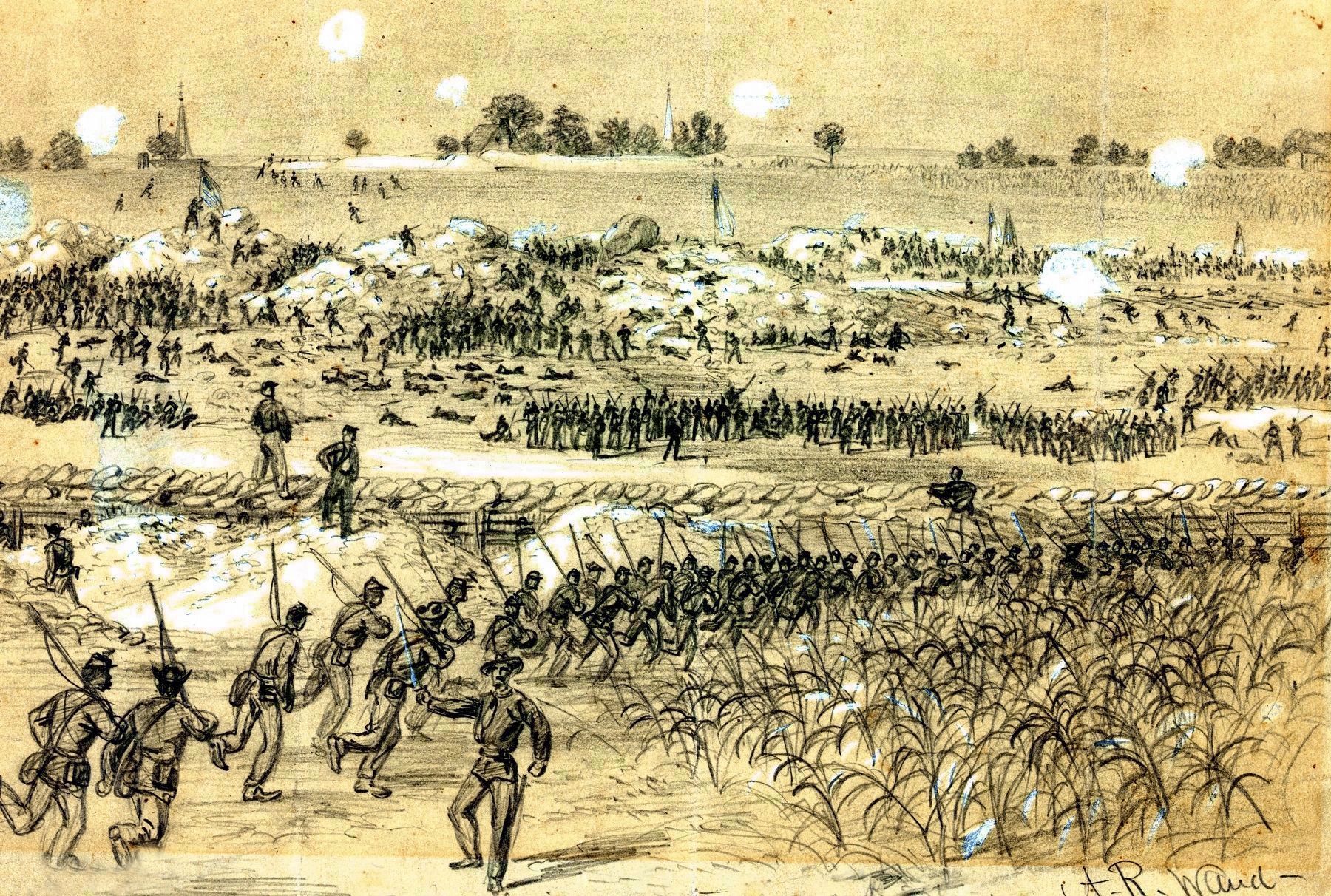Petersburg, Virginia — The American South (Mid-Atlantic)
Dash into the Crater
4:45 a.m. - 6:00 a.m.
— Petersburg National Battlefield —
At 4:45 a.m., Howard Aston of the 13th Ohio Cavalry reported, "A trembling of the earth was felt and a dull roar was heard. I looked to the front and saw a huge column of dirt, dust, smoke, and flame of fire apparently 200 feet high... while in the air I could see in the column of fire... bodies of men... timber and a gun carriage." Approximately two hundred and sixty Confederates were blow up and buried under the debris of the explosion. As the debris from the mine settled, the Union artillery opened upon the Confederates with about 150 pieces of cannons and mortars. These guns were soon answered by the Confederate artillery and the shriek and howl of solid shot and shell soon filled the air.
As Colonel Marshall's brigade cleared the Union earthworks in front of you, they advanced across no man's land, toward the enormous hole that was seething with smoke. They observed that it was filled " with dust, great blocks of clay, guns... and men buried in various ways." While the lead elements of Marshall's brigade made their way into the crater, they became rescue parties and started to dig out the buried Confederates. This action slowed the advance of the Union brigades and blocked the path to the heights beyond the crater. The 2nd Pennsylvania Provisional Heavy Artillery, however, was able to rush through the crater, get over the loose dirt, and reform among the bombproofs to the rear of the demolished sailent. At this point, Confederate infantry regrouped on the flanks of the Union soldiers and began to pour a light but persistent fire into the flank and rear of the men in the crater. This caused commands here and elsewhere in the crater to become quickly intermingled and confused.
Additional Union brigades would continue to file out of the covered ways and try and force their way through the Confederate line of trenches and bombproofs. As the crater became more crowded, regiments would try and push to the left and right of the pit in hopes of breaking through the Confederate line. Burnside's
worst fears were coming true. Instead of pushing for the Jerusalem Plank Road and Cemetery Hill, the Union brigades were starting to dig in and hold the position.
(caption)
The sketch by Alfred R. Waud (left) depicts Union soldiers filing through the covered ways and over the Union picket line towards the crater, which is to your front. The map (above) illustrates Union and Confederate movements after the mine was exploded during the early morning hours of July 30, 1864.
Erected 2014 by National Park Service, U.S. Department of the Interior.
Topics. This historical marker is listed in this topic list: War, US Civil. A significant historical date for this entry is July 30, 1864.
Location. Marker is missing. It was located near 37° 13.182′ N, 77° 22.46′ W. Marker was in Petersburg, Virginia. Marker could be reached from Siege Road, 0.4 miles east of South Crater Road (U.S. 301), on the right when traveling south. Marker is located at the end of the new "Concealment" walking trail at Tour Stop 8 on Petersburg National Battlefield's Eastern Front driving tour. Touch for map. Marker was at or near this postal address: 5001 Siege Road, Petersburg VA 23803, United States of America. Touch for directions.
Other nearby markers. At least 8 other markers are within walking distance of this location. The Struggle Across Poor Creek (within shouting distance of this marker); Digging the Mine
(about 500 feet away, measured in a direct line); Ventilation Shaft (about 600 feet away); Prelude to the Crater (approx. 0.2 miles away); A Fatal Error (approx. 0.2 miles away); The Crater (approx. 0.2 miles away); “A Stupendous Failure” (approx. 0.2 miles away); Confederate Counterattack (approx. 0.2 miles away). Touch for a list and map of all markers in Petersburg.
More about this marker. The battle map on the right shows the Union and Confederate movements during the early stages of the Battle of the Crater while the Alfred Waud sketch depicts Federals advancing toward the Crater.
Also see . . . Petersburg National Battlefield. National Park Service (Submitted on February 1, 2015.)
Additional commentary.
1. How to access the Concealment Trail.
At Tour Stop 8, upon reaching the entrance to the mine and the "Digging the Mine" marker, there is a small sign that reads "Concealment" and points toward the trail. A short 0.3 mile walk will take you to the
"Dash into the Crater" marker.
— Submitted January 31, 2015, by Shane Oliver of Richmond, Virginia.
Credits. This page was last revised on August 28, 2023. It was originally submitted on January 31, 2015, by Shane Oliver of Richmond, Virginia. This page has been viewed 590 times since then and 10 times this year. Last updated on October 22, 2021, by Bradley Owen of Morgantown, West Virginia. Photos: 1, 2. submitted on January 31, 2015. 3, 4. submitted on October 22, 2021, by Bradley Owen of Morgantown, West Virginia. 5. submitted on November 7, 2020, by Allen C. Browne of Silver Spring, Maryland. • J. Makali Bruton was the editor who published this page.
